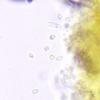
17-12-2025 18:35
 Michel Hairaud
Michel Hairaud
Bonjour à tous/Hi to everyone I am passing along

15-12-2025 15:48
 Danny Newman
Danny Newman
Melanospora cf. lagenaria on old, rotting, fallen

15-12-2025 15:54
 Johan Boonefaes
Johan Boonefaes
Unknown anamorph found on the ground in coastal sa

15-12-2025 21:11
 Hardware Tony
Hardware Tony
Small clavate hairs, negative croziers and IKI bb

15-12-2025 07:09
 Danny Newman
Danny Newman
indet. Rutstroemiaceae sp. on unk. fallen leavesMc

15-12-2025 07:05
 Danny Newman
Danny Newman
Pseudosclerococcum golindoi (det: Zotto)near Cosb

15-12-2025 11:49
 Danny Newman
Danny Newman
ITS sequences from the following two collections B

15-12-2025 12:34
 Danny Newman
Danny Newman
indet. Rhytismataceae on oak leafnear Purchase Roa

Bonjour,
Malheureusement je ne peux pas montrer une photo :-).
Nous avons trouvé un Cordyceps (ressemblant à militaris) très longue (ca 10 cm).
Les spores qu´on peut voir sont comme les spores d´un Hypocrea et on peut voir avec la loupe quelque chose jaune...
Les spores sont petites, (ca à 4) et prèsque rondes. Elles se séparent dans les ascis déjà.
Est-ce qu´on connaît des Hypocreas ou des autres sûr Cordyceps?
Merci,
Tanja

Hi Tanja,
if your fungus has 16 nearly isodiametrical part spores, it is a Hypocrea (or better a Trichoderma). Species with erect stromata have been classified in Podostroma. But with the colour of Cordyceps militaris this should be interesting. I only know H. leucopus and H. alutacea ,but maybe more species exist?
Regards from Lothar

Hallo Tanja,
schau doch mal bei Podostroma, ob da was passt?
Liebe Grüße,
Andreas :-)
Edit: Oh, sehe grad, dass Lothar auch schon geantwortet hat ....

Hello Thomas,
and what about Hypocrea nybergiana? Doesn't that comes close? Just judging from the key in JAKLITSCH ....
best regards,
Andreas

Hello Thomas,
Tanja said "Les spores sont petites, (ca à 4) et prèsque rondes. Elles se séparent dans les ascis déjà" Means "The spores are small (approx. 4 [µm]) and nearly globose. They are parting already in the ascus"
Therfore I'm interpreting this as Hypocrea spores. Hopefully Tanja will tell us something regarding that.
Hypocrea nybergiana is described in the key of JAKLITSCH (2011) like this:
Stromata large, to more than 10 cm long; fertile part reddish brown to brownish orange, pigment inhomogeneously distributed; distal ascospore cell 3.0–5.5×3.0–4.2 ?m; conidia large, 5–21×3–9 ?m, typically produced on solitary phialides.
May be worth tracing it ....
best regards,
Andreas

Hello,
I´m back home again....
I have one photo of the part-spores, but we also saw them (already divided) in the ascus.
I was really sure we had a C. militaris with a hypocrea/hypomyces on it, because on the fruitbody there were little yellow peritheciums.
best regards,
Tanja

Hello Tanja,
"I was really sure we had a C. militaris with a hypocrea/hypomyces on it, because on the fruitbody there were little yellow peritheciums."
This is an information you did not yet give us. A "Podostroma" can be excluded then.
Another information you did not give us (or do I overlook it?: where did you collect the fungus?
Regards from Lothar

Hallo Lothar,
Der Pilz wuchs in Schleswig-Holstein im Gebiet "Winderatter See". Das ist ein altes rinderbeweidetes Grünland mit vielen interessanten Arten (Erdzungen, Keulen, Saftlinge etc.). Normale Cordyceps militaris waren auch reichlich da und eben einige von den superlangen, die eben irgendwie befallen aussahen.
Leider hab ich den Pilz im Gelände nicht ausreichend beachtet und wir haben nur den einen Fruchtkörper mitgenommen. Es war einfach zu viel da...
Viele Grüße,
Tanja

Hallo Tanja,
schau doch mal hier nach:
Moingeon, J.-M. (2004): Hypomyces et genres apparentés. - Bull. Féd. myc. Dauph.-Sav. 172: 31-48.
steht bei uns im Regal ;-)
beste Grüße,
Andreas


